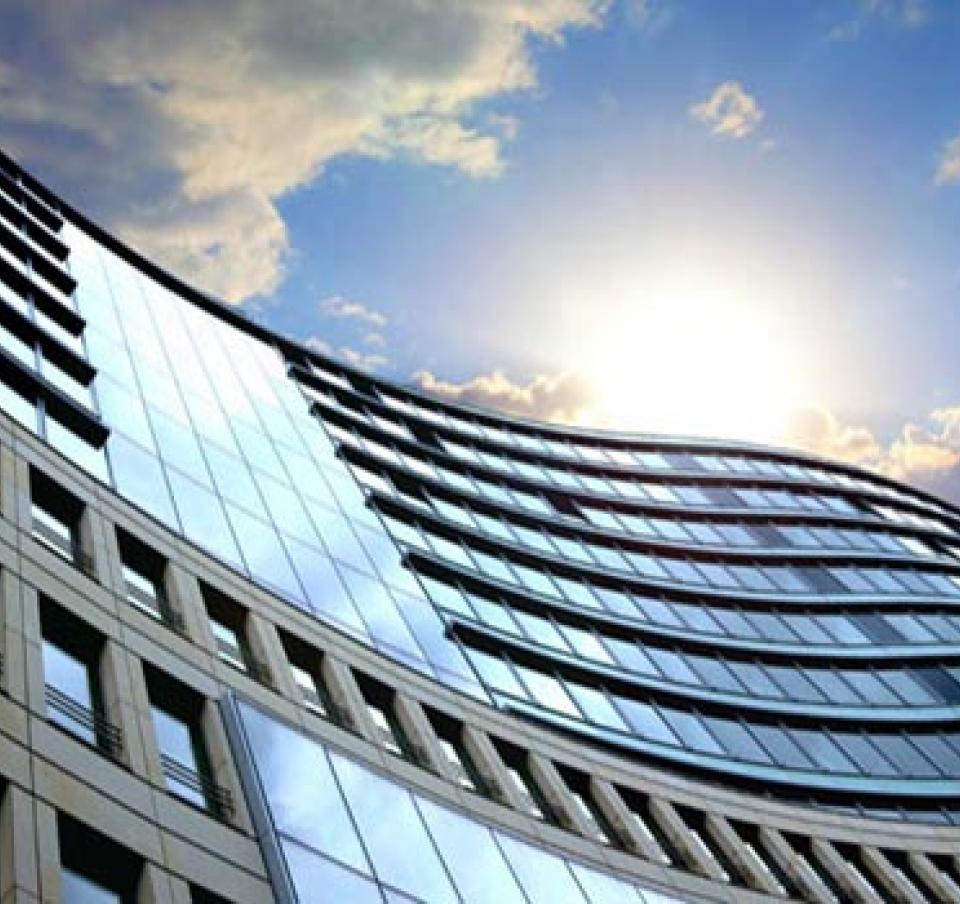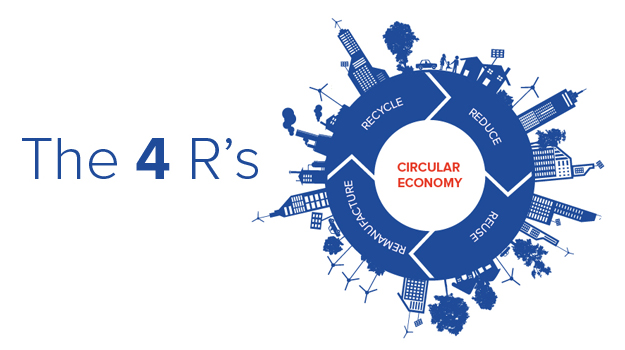There has been a visible shift amongst clients, developers and architects, with increasing focus on the sustainability of a building and the materials required for its construction.

With our planet in the throes of a climate emergency, the built environment and the construction industry has, unsurprisingly, come under great levels of scrutiny, resulting in a desire to change. As a result, there has been a visible shift amongst clients, developers and architects, with increasing focus on the sustainability of a building and the materials required for its construction.
One regularly occurring phrase when discussing a building material’s environmental impact is the ‘circular economy’. As discussed in our blog ‘Steel and the Circular Economy’, unlike the ‘cradle to grave’ approach, which considers a product’s impact up to the end of its life, a circular economy takes into account a material’s value beyond this point. Indeed, a fundamental part to a circular economy is there being no ‘grave’, no waste and no end to the continuous loop.
However, in order for this ‘no waste’ culture to be truly realised, there needs to be a fundamental change in how people view objects; to reverse our modern-day ‘throw away’ attitude and to re-think the way that we are currently using our materials, including energy. Essentially, we would need to transform from a linear society – one in which we extract raw materials, manufacture products and, at the end of their use, dispose of the same – to a circular society, in which we endeavour to maintain the value of materials and reduce or eliminate waste by reusing, remanufacturing or recycling our products.
What is the position of steel compared to other building materials if we look at circular economy?
If we consider the end-of-life scenarios of the three key building materials – concrete, timber and steel - we can see that there are considerable differences. Ultimately, the best option is to first reuse a building product before then recycling it – in steel’s case, recycling would mean re-melting. One of the worst options is to send the material to landfill at the end-of-life.
Reduce – How can you reduce waste?
The steel industry has seen significant improvements over the past few decades in terms of resources consumed and waste generated, both during production and in use. For example, did you know that the amount of energy required to produce a tonne of steel in the UK has been reduced by around 40% since the 1970s?[[1]]
At Tata Steel, we are dedicated to ensuring that such trends continue, which is we continue to drive investment in breakthrough technology that will deliver our ambition of being a carbon neutral steel maker beyond 2050.
Another area of steel production that continues to contribute towards waste reduction is the development of High Strength Steel, with improved strength to weight ratios enabling architects and contractors to reduce the amount of steelwork needed on a project, without compromising on the overall quality or performance of the structure. Lighter steel can also result in savings elsewhere on a construction project, including concrete foundations – the most widely used man-made material in existence and often criticised for its lack of circular economic ‘capability’ – and less transport being required to deliver the building materials to site, key considering that 25% of all road traffic is presently construction-related.
Indeed, the application of High Strength Steel is capable of reducing the overall CO2 footprint of a building by as much as 20 - 30%. The Burj Khalifa Tower in Dubai, presently the world’s tallest building, is a great example of this, with the use of Tata Steel’s high-strength ComFlor® 80 steel for the upper floors allowing for increased spans and reduced structural steelwork within the building.
Reductions can also be made in the ‘in-use’ phase of a building. Here, steel can provide an excellent base for renewable energy solutions, including integrated photovoltaics and transpired solar collectors, such as Colorcoat Renew SC®, which both harvest solar energy and help to reduce non-renewable energy consumption.
Reuse – How can you reuse the material or product?
This is an area of significant opportunity for steel – particularly within the construction industry. Imagine a building where, once it reaches the end of its life, rather than being demolished and sent to landfill, the structural components can simply be removed or disassembled and reused elsewhere, further extending each product’s life cycle.
An example of this is Fokker 7|8, a new distribution centre in the Netherlands and the first cradle-to-cradle optimised logistics building in the world. Tata Steel worked together with Delta Development Group, fortune top Eco-innovator Zagariasse, to design the 100% circular distribution center, with the predominant focus being to ensure the ability to reuse materials and components many years down the line. Even relatively simple design changes can offer great opportunities for reuse, such as working almost exclusively with bolted or screwed connections - as opposed to welded connections - in the main steel supporting structure. As a result of the collaboration, all building material data was subsequently captured in a materials passport.
This idea of a materials passport was first developed by Thomas Rau, a Dutch architect, who has been working to build a public database of materials in existing buildings and their potential for reuse, stating that “we have to start thinking of buildings as material depots.”
Remanufacture – Are you able to remanufacture the product?
Thanks to steel’s innate durability, many steel products are also well-suited to being remanufactured – a method of restoring used products to a like-new condition. Offshore energy is one industry segment where remanufacturing is of particular value. Remanufactured turbines can help keep wind farms at peak capacity long beyond their designed lifetime and almost double the return on original investment, potentially extending turbine life by up to 20 years.[[2]]
Our Colorcoat® pre-finished steel has been developed to extend the metal’s inherent durability even further, aiding both reuse and remanufacture. With a multi-layer manufacturing process and unique coating formulations, we are able to offer the industry a building material that combines exceedingly high levels of performance and corrosion resistance with stunning aesthetics.
Recycling – Are you able to efficiently recycle any waste material?
The final R is where steel really shines – excuse the pun. Indeed, steel is said to be the most recycled material in the world, with around 630 million tonnes of steel scrap recycled every year.[[3]] With the construction industry said to be responsible for generating up to 60% of the UK’s total waste,[[4]] a building material with such a well-established recycling process is evidently a valuable part of the industry and a crucial part of achieving a circular economy.
What’s more, steel is perhaps one of the few materials that can effectively be upcycled, being used to produce a product of higher strength or capability than its original form – unlike downcycling, which could be seen as moving the product or material one step closer to landfill. Indeed, given the ultimate aim of the Circular Economy is to keep materials in the economy cycle, downcycling should really be avoided where possible.
If we look at present practice in construction, it is evident that there is still a long way to go. Even in a top recycling country like the Netherlands, of the 24 million tonnes of construction waste per year 90% is stone and concrete, with 97% of this downcycled into low-grade base material for roads and only 2% being recycled back into granulate for concrete.[[5]]
What does the future of building construction look like with steel’s Circular Economy?
The picture with steel looks completely different. When a building becomes obsolete, the façade cladding can be easily replaced, thanks to it being fixed with removable screws, and services can be upgraded. In the case of a building requiring demolition, the steel structural beams and cladding have the potential to be removed and reused.
At Tata Steel, we believe that only by taking a complete life cycle perspective can we both optimise the use of the world’s limited resources and reduce waste. Circular economic thinking is a key part of that solution, from initial product design to end-of-life and beyond. Steel has an important role, and capability, in delivering our circular economic and sustainable future.
[[1]] Derived from UK Steel data
[[2]] https://www.worldsteel.org/about-steel/steel-facts.html
[[3]] https://www.worldsteel.org/about-steel/steel-facts.html
[[4]] ‘The case for a resource exchange mechanism’, MI-ROG, 2019
[[5]] https://www.cobouw.nl/



































































































































































































































